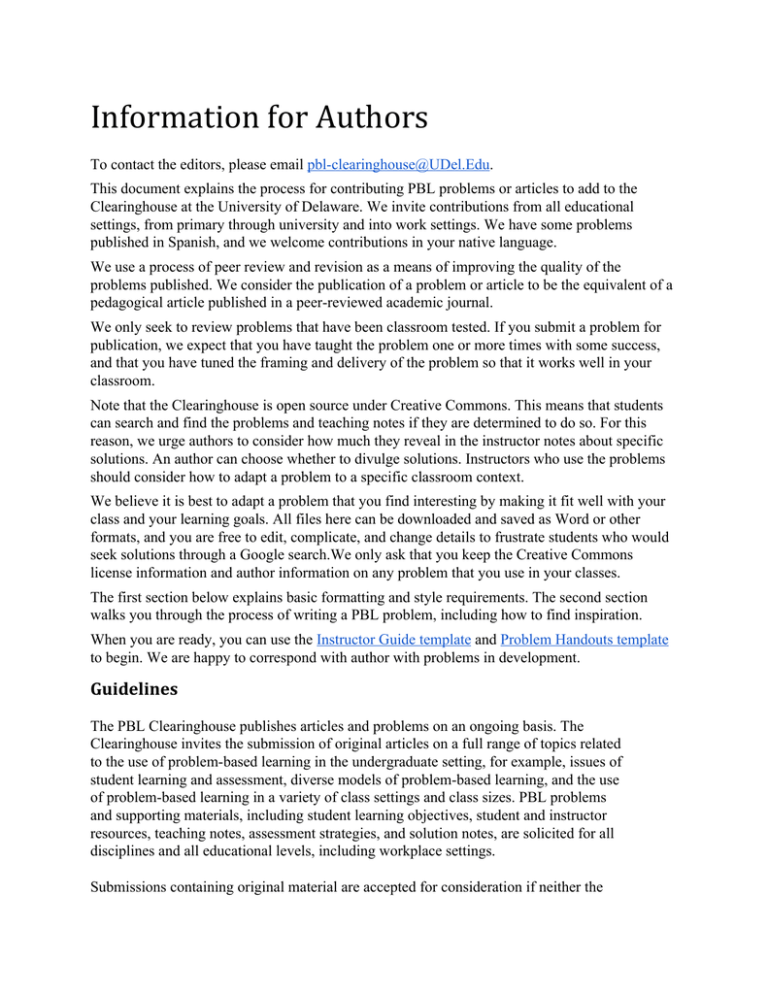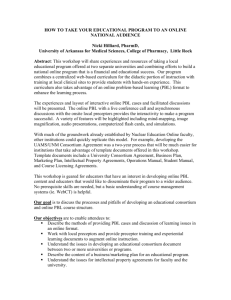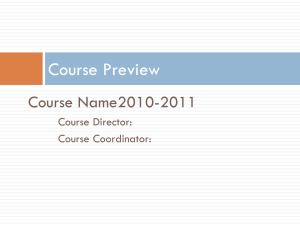Information for Authors
advertisement

Information for Authors To contact the editors, please email pbl­clearinghouse@UDel.Edu . This document explains the process for contributing PBL problems or articles to add to the Clearinghouse at the University of Delaware. We invite contributions from all educational settings, from primary through university and into work settings. We have some problems published in Spanish, and we welcome contributions in your native language. We use a process of peer review and revision as a means of improving the quality of the problems published. We consider the publication of a problem or article to be the equivalent of a pedagogical article published in a peer­reviewed academic journal. We only seek to review problems that have been classroom tested. If you submit a problem for publication, we expect that you have taught the problem one or more times with some success, and that you have tuned the framing and delivery of the problem so that it works well in your classroom. Note that the Clearinghouse is open source under Creative Commons. This means that students can search and find the problems and teaching notes if they are determined to do so. For this reason, we urge authors to consider how much they reveal in the instructor notes about specific solutions. An author can choose whether to divulge solutions. Instructors who use the problems should consider how to adapt a problem to a specific classroom context. We believe it is best to adapt a problem that you find interesting by making it fit well with your class and your learning goals. All files here can be downloaded and saved as Word or other formats, and you are free to edit, complicate, and change details to frustrate students who would seek solutions through a Google search.We only ask that you keep the Creative Commons license information and author information on any problem that you use in your classes. The first section below explains basic formatting and style requirements. The second section walks you through the process of writing a PBL problem, including how to find inspiration. When you are ready, you can use the Instructor Guide template and Problem Handouts template to begin. We are happy to correspond with author with problems in development. Guidelines The PBL Clearinghouse publishes articles and problems on an ongoing basis. The Clearinghouse invites the submission of original articles on a full range of topics related to the use of problem­based learning in the undergraduate setting, for example, issues of student learning and assessment, diverse models of problem­based learning, and the use of problem­based learning in a variety of class settings and class sizes. PBL problems and supporting materials, including student learning objectives, student and instructor resources, teaching notes, assessment strategies, and solution notes, are solicited for all disciplines and all educational levels, including workplace settings. Submissions containing original material are accepted for consideration if neither the problem nor any part of its essential substance has been or will be published or submitted elsewhere before appearing in the PBL Clearinghouse. A manuscript described below may refer to an article or a problem. Please refer to our Problem Writing Guide below for suggestions on writing good PBL problems. Authors' Names Names, affiliations, and addresses must be provided for all authors. The template will show an example of the information needed. Abstracts Provide an abstract of no more than 250 words in the designated space. The abstract should be clear and informative and give an indication of the scope of the article and its main arguments. Abbreviations Abbreviations in the text should be used sparingly and should be explained at the first occurrence. Abbreviations and other conventions (capitals, italics, symbols) should be used consistently throughout the article. Numbers, Dates Numbers below 10 should be expressed in words. Four figure numbers should have a comma, thus, 4,000. Decades should be written ‘the 1950s.’ Dates in the text should be written in full, thus: 24 September 1994. Tables/Figures Tables and figures should be numbered with Arabic numerals in the order in which they are cited in the text of the article. A table/figure title should describe the content of the table, so that the table/figures can be understood without reference to the text. Give the units of measure for all numerical data in a table or figure. References Please avoid the use of footnotes or endnotes in the article manuscripts. References to other works in the text of the manuscript should be indicated by author last name and page number within parentheses at the end of the appropriate sentence. References for tables and figures should be similarly cited. A complete list of references, or works cited, should be provided at the end of the manuscript. Please conform to American Psychological Association (APA) guidelines on how to cite books, journals, other media sources, or electronic information. An adaptation of the APA Style Guide is available online at http://www.lib.usm.edu/index.php?id=81 . Review and Action Manuscripts are vetted by topical editors and sent to appropriate reviewers. An initial decision about a manuscript should be sent to the author within four weeks. Manuscripts will initially be rejected, accepted, or accepted pending minor or major revisions. For information about the status of a submitted manuscript, send email to: pbl­clearinghouse@udel.edu . Problem Writing Guide Characteristics of Good Problems In a PBL course, the selection of appropriate problems is critical to the success of the course. The following is a list of the important characteristics of a good PBL problem: 1. An effective problem must first engage students' interest and motivate them to probe for a deeper understanding of the concepts being introduced. It should relate the subject to the real world so that students have a stake in solving the problem. If at all possible, the problem should be placed in a context with which students are familiar. 2. Good problems require students to make decisions or judgments based on facts, information, logic, and/or rationalization. Students should be required to justify all decisions and reasoning based on the principles being learned. Problems should require students to define what assumptions are needed (and why), what information is relevant, and/or what steps or procedures are required in order to solve the problem. Not all the information given in the problem should be relevant to a solution and not all the information needed for a solution should be initially given to the student. For this reason, many PBL problems are designed with multiple stages to be given to student groups one at a time as they work through the problem. 3. A problem presupposes that something must be solved and that there is likely to be more than one potential solution. A problem differs from an assignment. An assignment tells students to do something specific. A problem puts students in a situation that calls for problem­solving behaviors. 4. PBL assumes that students work in teams. Cooperation from all members of the student group will be necessary in order to effectively work through a good problem. The length and complexity of the problem or case must be controlled so that students realize that a "divide and conquer" effort will not be an effective problem­solving strategy. For example, a problem that consists of a series of straight­forward "end of chapter" questions would be divided by the group and assigned to individuals, then reassembled for the assignment submission. In this case, students would learn less not more . 5. The initial questions on the first stage of a problem should be open­ended, based on previously learned knowledge, and/or controversial so that all students in the groups are quickly drawn into a discussion of the topic. This strategy keeps the students functioning as a group, rather than encouraging them to work individually at the outset of the problem. 6. The content objectives of the course should be incorporated into the problems, connecting previous knowledge to new concepts, and connecting new knowledge to concepts in other courses and/or disciplines. 7. The problem's questions should challenge students to develop higher­order thinking skills, moving them beyond Bloom's (1956) lower cognitive levels of knowledge and comprehension to the higher Bloom levels, where they analyze, synthesize, and evaluate. Table 1. Bloom's Cognitive Levels Cognitive Level Student Activity Knowledge Remembering facts, terms, concepts, definitions Comprehension Explaining and interpreting the meaning of material Application Using a concept or principle to solve a new problem Analysis Breaking material down into its parts to see relationships Synthesis Producing something new from component parts Evaluation Making a judgment based on criteria Sources of Good Ideas for Problems So now that we know what makes a good problem for use in PBL—how can you write one? Some faculty use video­clips, stories, novels, articles in the popular press, and research papers as a basis of a problem. Frequently, faculty members use a typical textbook problem and rewrite it as an open­ended, real world problem. You might think of following the following steps to writing a PBL problem: Step 1. Choose a central idea, concept or principle that you always teach in your course. Then, think of a typical end­of­chapter problem, assignment, or homework that you tend to assign to students when you teach that concept. List the learning objectives you want students to meet when they work through the problem. Step 2. Think of a real­world context for the concept you've chosen. At this point, you could think of a storytelling aspect to an end­of­chapter problem. This adds some motivation for students to solve the problem and it requires students to go beyond simple "plug­and­chug" in order to do so. Look at magazines, newspapers, and articles for ideas on the "story­line.” You might think of talking to professional in the field for ideas of realistic applications of the concept you are teaching. Step 3. At this point, you want to flesh out the problem by asking yourself some of these questions: ● What will the first page look like? What open­ended questions can I ask? ● How will I structure the problem? ● How long will the problem be? How many class periods will it take to complete? ● Will I give students information in subsequent pages as they work through the problem? ● What resources will students need? ● What end­product will students produce at the completion of the problem? Usually PBL problems are multi­stage or multi­page and may take student groups a week or more to complete. Not all the information needed to solve the problem is given in the problem, or chapter, or perhaps even in the textbook. Students will need to do some research, discover new material, and arrive at judgments and decisions based on the information learned. The problem may have more than one acceptable answer based on the assumptions students make. Step 4. Write an instructor guide detailing how you plan to use the problem in your course. If you are using a combination of mini­lectures, whole class discussion, small group work with groups regularly reporting out to the whole class, you will want to indicate how you plan to cycle through the pages of the problem interspersing the various modes of learning. A template for the instructor guide can be found on the main page, as can a template for a problem. Text of “Problem Writing Guide” © Barbara Duch, University of Delaware, 2001 Edited by Dr. Stephen A. Bernhardt and Erin Huston, UD, 2015




